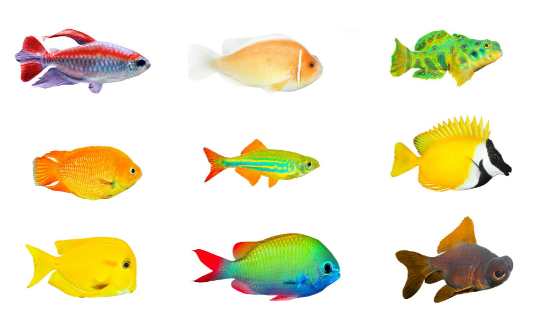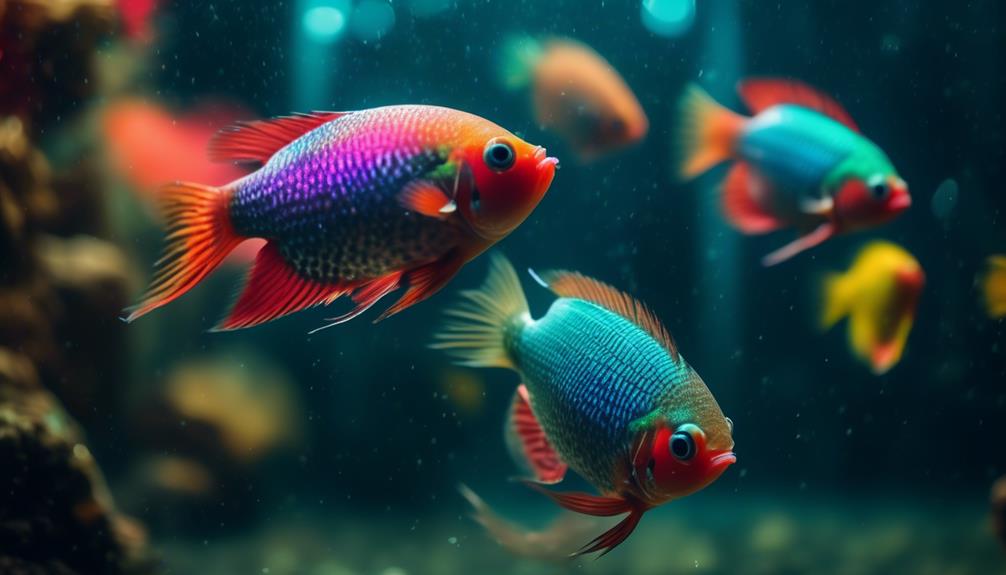
Are you curious about how to breed the stunning and vibrant colorful gourami fish? Imagine having your own little ecosystem filled with these captivating creatures, each showcasing a unique and mesmerizing color palette.
Well, you’re in luck! In this discussion, we will uncover the secrets behind successfully breeding these magnificent fish. From selecting the perfect breeding pair to creating the ideal breeding environment, we will reveal the intricacies of bubble nest building and how to navigate potential challenges.
Get ready to unlock the secrets of breeding colorful gourami fish and witness the beauty that awaits.
Key Takeaways
- Breeding gouramis requires a separate aquarium with dim lighting and plenty of plants.
- Select gouramis that are in good health and free from diseases or deformities.
- Provide a suitable tank size and create a well-designed breeding environment.
- Feed gourami fry with infusoria, baby brine shrimp, and microworms, and monitor water conditions regularly.
Gourami Breeding Basics
Breeding gouramis requires a separate aquarium where the male builds bubble nests to care for the eggs and fry. This special breeding tank should be dimly lit and well planted to create a suitable environment.
The male gourami takes the lead in breeding, constructing bubble nests using saliva-covered bubbles. Once the nest is ready, the female gourami is introduced into the breeding aquarium for spawning.
During spawning, the male fertilizes the female’s eggs in a characteristic embrace. After spawning, it’s crucial to remove the female from the breeding tank to prevent her from eating the eggs or disturbing the fry.
The male gourami diligently tends to the eggs and fry, ensuring their safety and well-being until they hatch and become independent.
Selecting a Breeding Pair
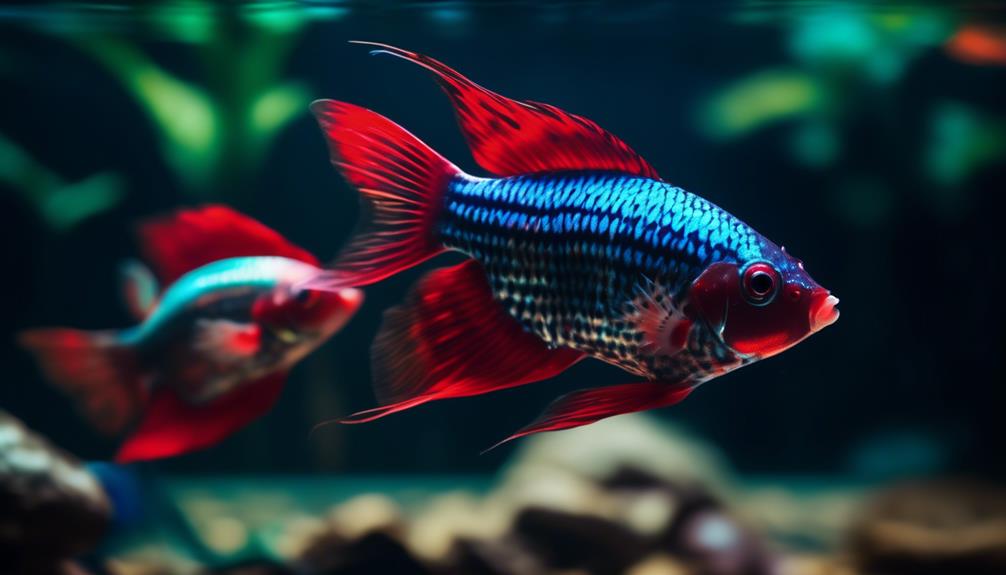
Now that you understand the basics of breeding gouramis, let’s move on to selecting a breeding pair.
When choosing a breeding pair, there are a few key factors to consider:
- Compatibility: Ensure that the male and female gouramis are compatible with each other. They should display similar behavior and temperament to avoid conflicts during the breeding process.
- Health and Condition: Select gouramis that are in good health and free from any diseases or deformities. Healthy fish have a higher chance of successful breeding and producing healthy offspring.
- Physical Characteristics: Look for gouramis that exhibit vibrant colors and distinct patterns. These physical features are often passed on to their offspring, resulting in a visually appealing and diverse brood.
Setting Up the Breeding Tank
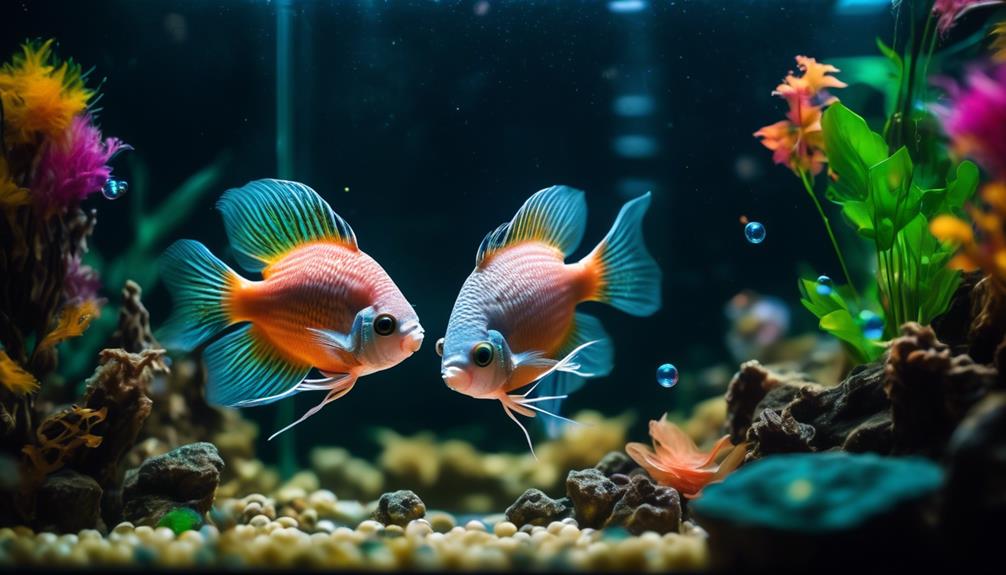
To properly set up the breeding tank for gouramis, you’ll need to consider a few essential factors.
First, choose a tank size that’s suitable for the number of gouramis you plan to breed. A 20-gallon tank is usually sufficient for a pair of gouramis.
Next, create a dimly lit environment by using floating plants or a dimming light fixture. This will help simulate their natural breeding conditions.
Additionally, provide plenty of hiding places using live plants or artificial decorations. Gouramis like to have hiding spots to feel secure during the breeding process.
Lastly, maintain a stable water temperature of around 78-82°F and a pH level of 6.0-7.0. These factors will help create an ideal breeding environment for your gouramis.
Creating the Ideal Breeding Environment
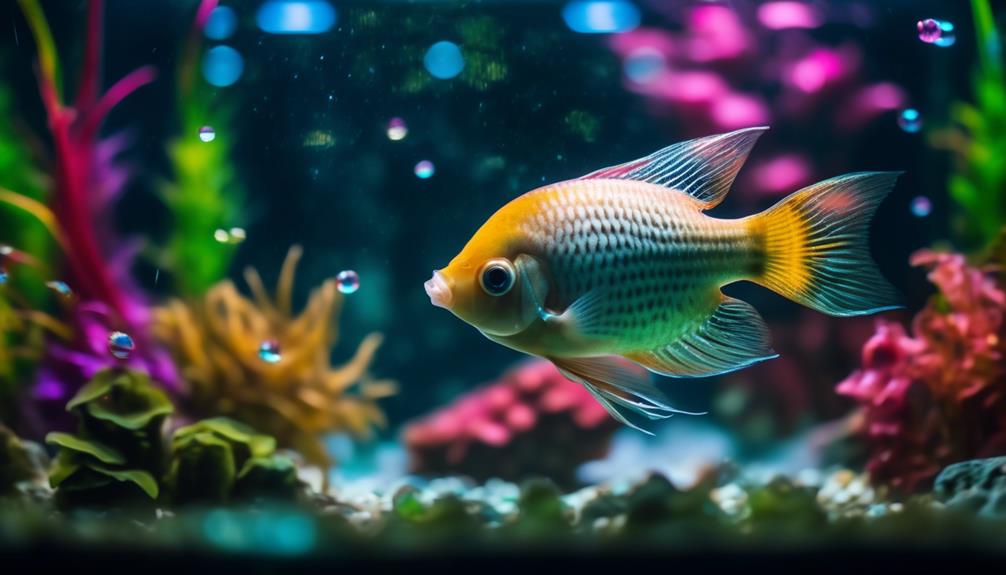
To create the ideal breeding environment for your gouramis, ensure that the aquarium is equipped with the necessary elements for their comfort and reproductive success. Here are some key factors to consider:
- Water quality: Maintain clean and properly filtered water with the right temperature and pH levels. Gouramis prefer slightly acidic to neutral water conditions.
- Lighting and plants: Provide dim lighting in the breeding tank to mimic their natural habitat. Include plenty of live plants for hiding spots and to encourage the formation of bubble nests.
- Adequate space: Gouramis require enough space to swim and establish territories. Avoid overcrowding the tank to reduce stress and aggression.
Understanding Bubble Nest Building
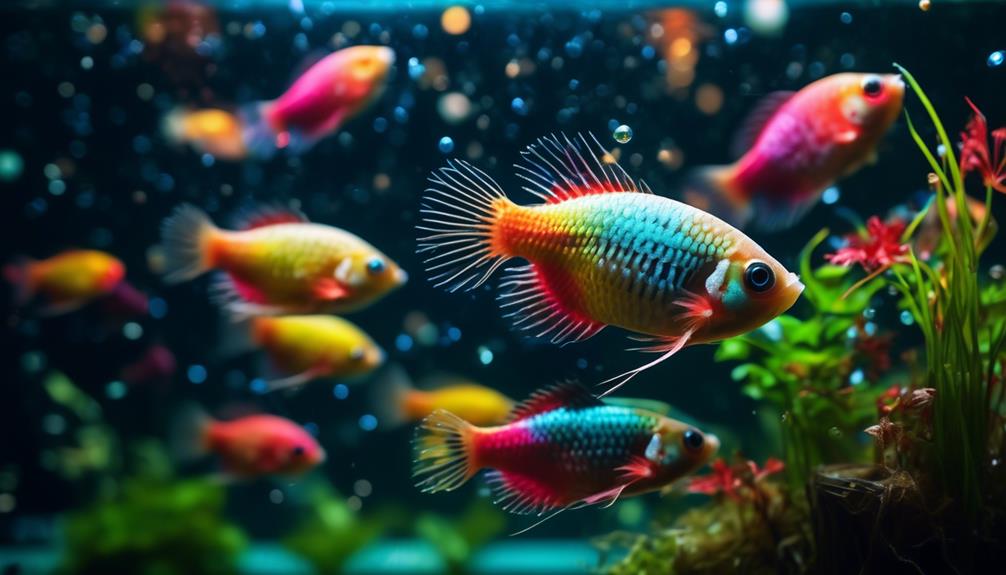
Understanding how gouramis build bubble nests is essential for successful breeding.
Male gouramis are responsible for constructing these nests, which are made up of saliva-covered bubbles. The process begins with the male creating a cluster of bubbles at the water’s surface. He then gathers more bubbles and adds them to the cluster, forming a floating nest.
The purpose of the bubble nest is to provide a safe and secure environment for the eggs. Once the nest is complete, the male will entice the female to spawn by performing a characteristic embrace. During this embrace, the male fertilizes the eggs and the female releases them.
After spawning, the male takes on the role of caretaker, guarding the nest and tending to the eggs and fry.
Understanding the intricacies of bubble nest building will greatly increase your chances of successfully breeding gouramis.
The Spawning Process
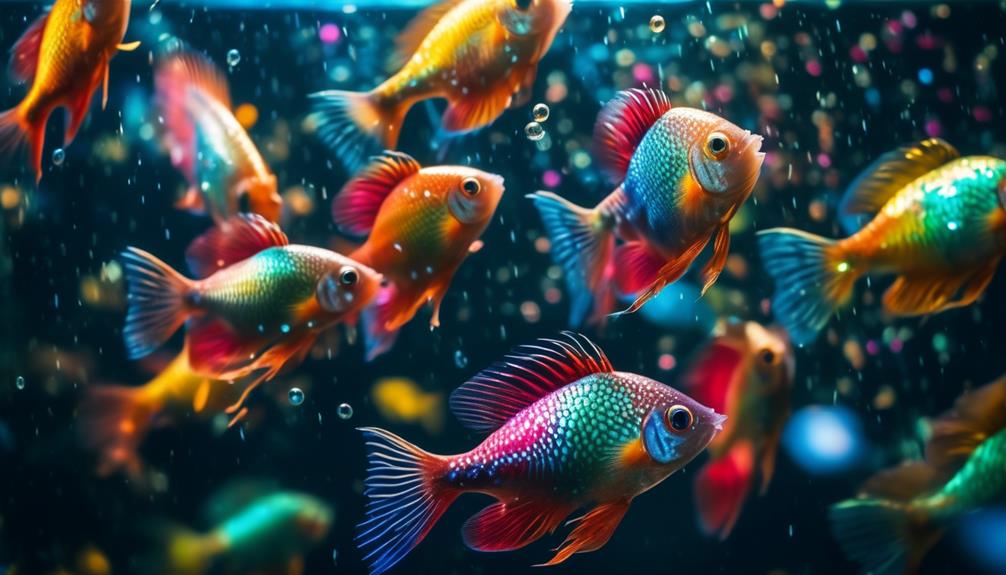
After successfully constructing the bubble nest, the male gourami proceeds to initiate the spawning process. This is the crucial step in breeding colorful gourami fish.
Here’s what happens during the spawning process:
- The male gourami entices the female to approach the bubble nest.
- The male wraps his body around the female in a characteristic embrace.
- During this embrace, the male releases milt, which fertilizes the female’s eggs.
It is important to note that the male gourami takes on the responsibility of caring for the eggs and fry.
After the spawning process, it’s advisable to remove the female from the breeding aquarium to prevent any potential harm to the eggs. This ensures the best chance of survival for the fry.
Caring for the Eggs and Fry
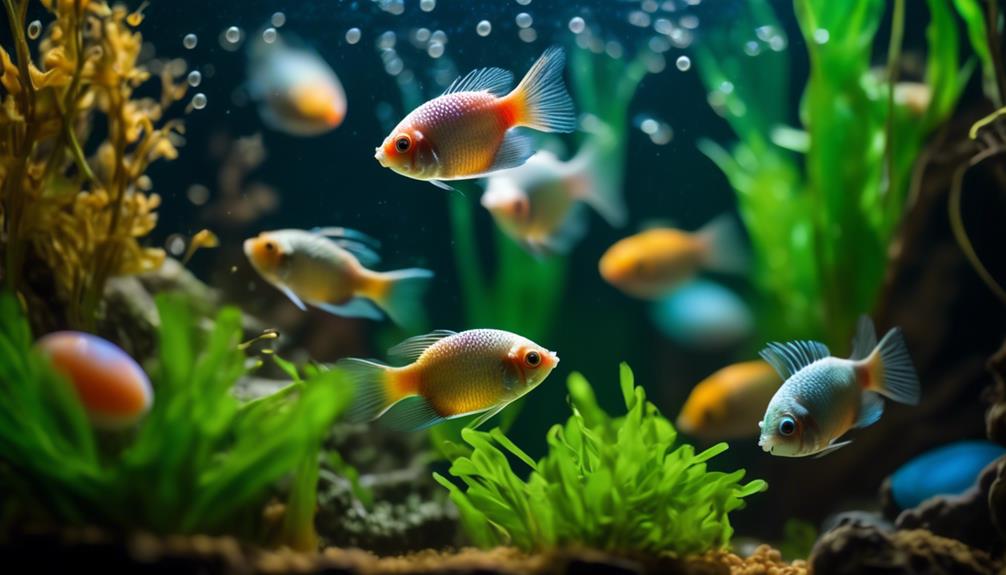
When caring for the eggs and fry of colorful gourami fish, it’s important to provide a suitable environment for their growth and development. After the male gourami has fertilized the eggs and built his bubble nest, he’ll take on the responsibility of caring for them.
It’s crucial to maintain the water temperature at around 78-82 degrees Fahrenheit and ensure that the water quality is pristine. To prevent the eggs from being eaten by other fish, it’s recommended to separate the male along with the bubble nest into a separate aquarium.
The eggs will hatch within 24-48 hours, and the fry will start swimming freely after another 3-4 days. At this stage, it’s important to provide them with small, live food such as infusoria or newly hatched brine shrimp.
Regular water changes and monitoring of the fry’s growth will be necessary to ensure their health and well-being.
Removing the Female From the Tank
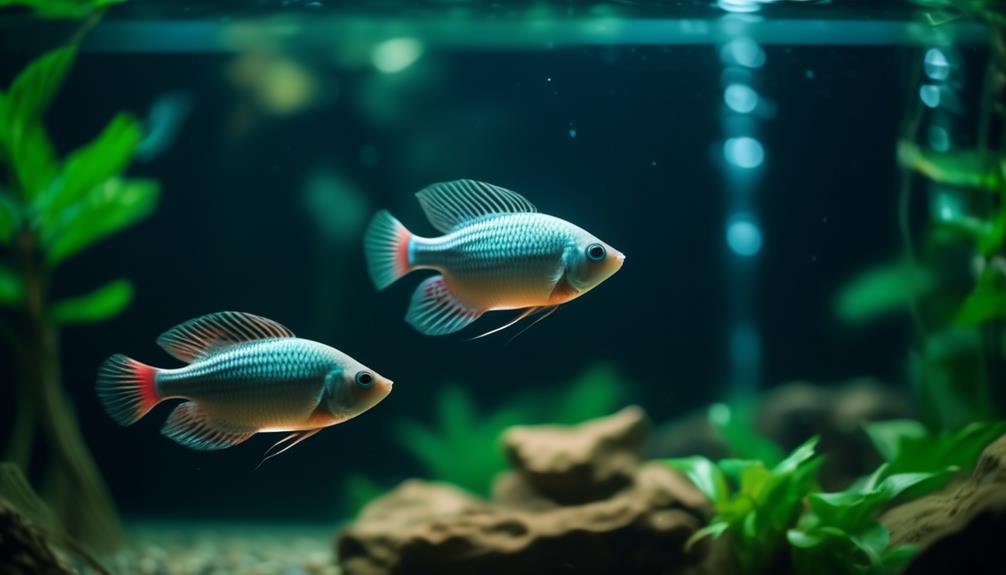
To successfully breed colorful gourami fish, it’s important to remove the female from the tank after spawning occurs. This is crucial for the well-being of the eggs and fry, as the female may eat them if left in the breeding aquarium. Removing the female also prevents her from being harassed by the male, who may become territorial after spawning.
Here are three reasons why removing the female is necessary:
- Protection of the eggs and fry: By removing the female, you ensure that the eggs and fry aren’t at risk of being eaten. This increases their chances of survival and allows the male to take care of them without any interference.
- Preventing stress and aggression: The male gourami can become aggressive towards the female after spawning. Removing her from the tank reduces stress levels and eliminates the potential for aggression.
- Maintaining a peaceful breeding environment: Taking out the female creates a more peaceful and harmonious environment for the male and the developing fry. It allows the male to focus on his paternal duties without distractions.
Feeding the Fry for Optimal Growth
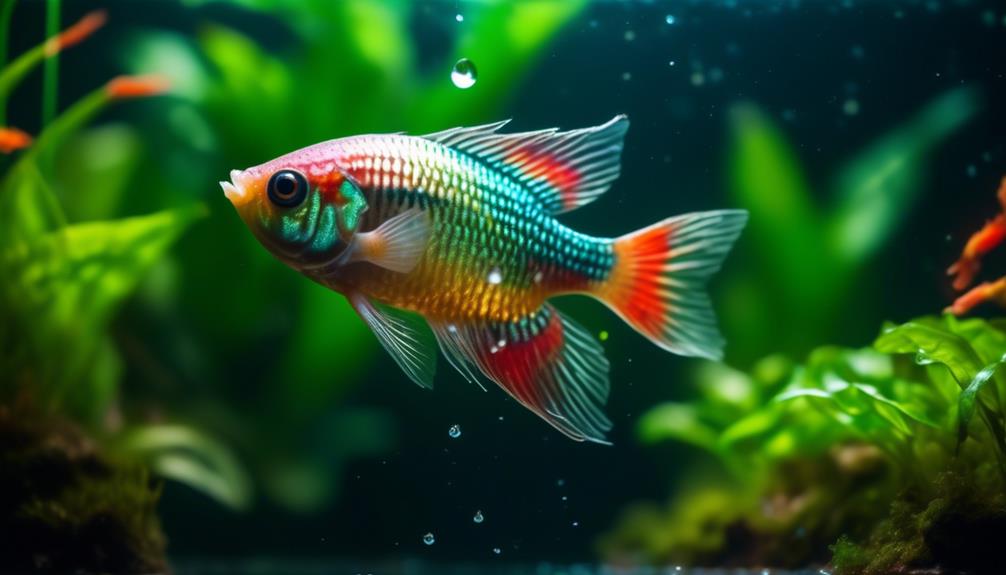
Removing the female from the tank after spawning ensures the well-being of the eggs and fry, and now it’s crucial to focus on feeding the fry for optimal growth. Providing the right nutrition is key to ensure their healthy development. Here is a table that outlines the ideal diet for gourami fry:
| Food Type | Frequency | Quantity |
|---|---|---|
| Infusoria | Daily | Small |
| Baby brine shrimp | Twice a day | Moderate |
| Microworms | Twice a day | Small |
Infusoria, tiny aquatic organisms, should be the primary food source for the first few days. As the fry grow, you can gradually introduce baby brine shrimp and microworms into their diet. These live foods provide essential nutrients and promote rapid growth. Remember to feed them small portions multiple times a day to ensure they receive enough nourishment without overfeeding. Monitor their growth closely and adjust the feeding schedule and quantities accordingly. Happy and well-fed fry will develop into vibrant and healthy adult gouramis.
Monitoring Water Conditions
To ensure the health and well-being of your gourami fish, it’s important to carefully monitor the water conditions in their aquarium. Here are three key aspects to consider:
- Temperature: Gouramis thrive in water temperatures between 75-82°F (24-28°C). Use a reliable aquarium thermometer to maintain a stable temperature within this range.
- pH Level: Gouramis prefer slightly acidic to neutral water, with a pH range of 6.0-7.5. Regularly test the water using a pH testing kit and make necessary adjustments using pH adjusters or buffers.
- Water Quality: Maintain good water quality by regularly performing partial water changes, removing debris, and using a high-quality filtration system. This will help to keep ammonia, nitrite, and nitrate levels in check, ensuring a healthy environment for your gouramis.
Dealing With Potential Breeding Challenges
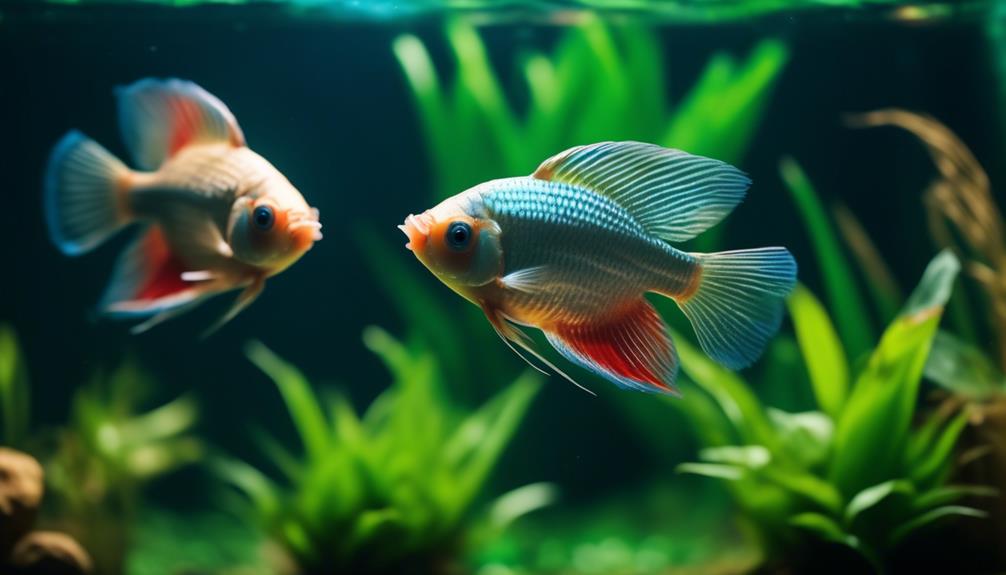
Breeding gouramis can present various challenges that require careful attention and preparation. While gouramis are relatively hardy fish, there are a few potential obstacles you may encounter during the breeding process. One challenge is ensuring the compatibility of the breeding pair. It is crucial to choose a male and female gourami that are of the same species and similar size. Another challenge is creating the right conditions for successful breeding. This includes providing a separate dimly lit and well-planted breeding tank, as well as maintaining the water temperature between 78-82°F. Lastly, you may face difficulties in successfully raising the fry. It is essential to provide them with proper nutrition and a suitable environment to ensure their survival. By addressing these potential challenges, you can increase your chances of successfully breeding colorful gourami fish.
| Potential Breeding Challenges | Solutions |
|---|---|
| Compatibility of breeding pair | Choose a male and female gourami of the same species and similar size. |
| Creating suitable breeding conditions | Provide a separate dimly lit and well-planted breeding tank with a water temperature of 78-82°F. |
| Raising the fry | Ensure proper nutrition and create a suitable environment for the fry’s survival. |
Preventing Egg-Eating Behavior
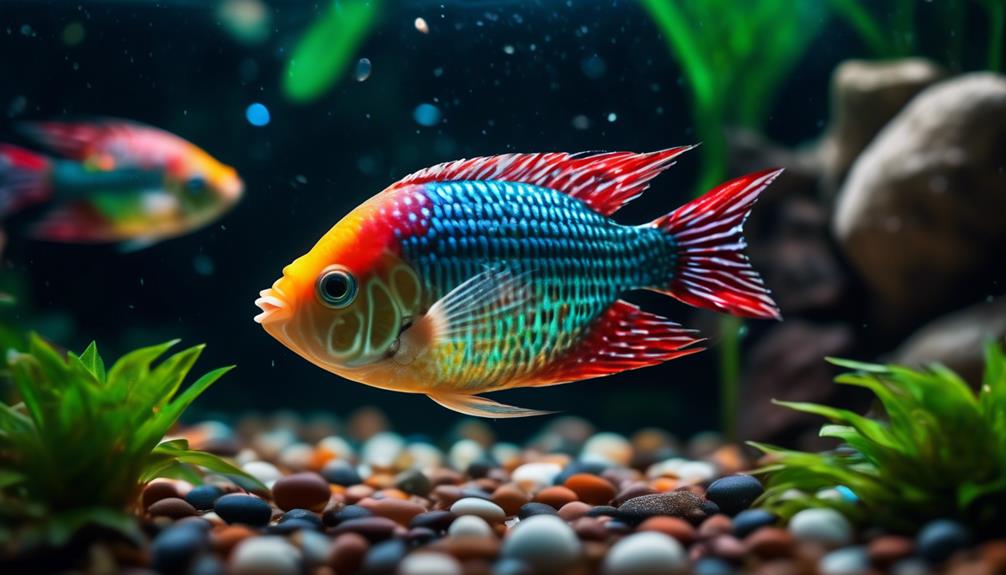
If you want to successfully breed colorful gourami fish, it’s important to address the issue of preventing egg-eating behavior. Gouramis are known to consume their own eggs, which can be frustrating for breeders. To avoid this problem, here are some strategies you can implement:
- Provide ample hiding places: Gouramis are more likely to eat their eggs if they feel stressed or threatened. By creating hiding spots in the breeding tank, such as plants or caves, you can give the fish a sense of security and reduce the likelihood of egg consumption.
- Separate the male and female after spawning: Once the eggs are fertilized, it’s best to remove the female from the breeding tank. This prevents her from eating the eggs and allows the male to take care of them without interference.
- Feed the fish well: A well-fed gourami is less likely to resort to cannibalism. Make sure to provide a balanced diet that meets their nutritional needs.
Tips for Successful Gourami Breeding
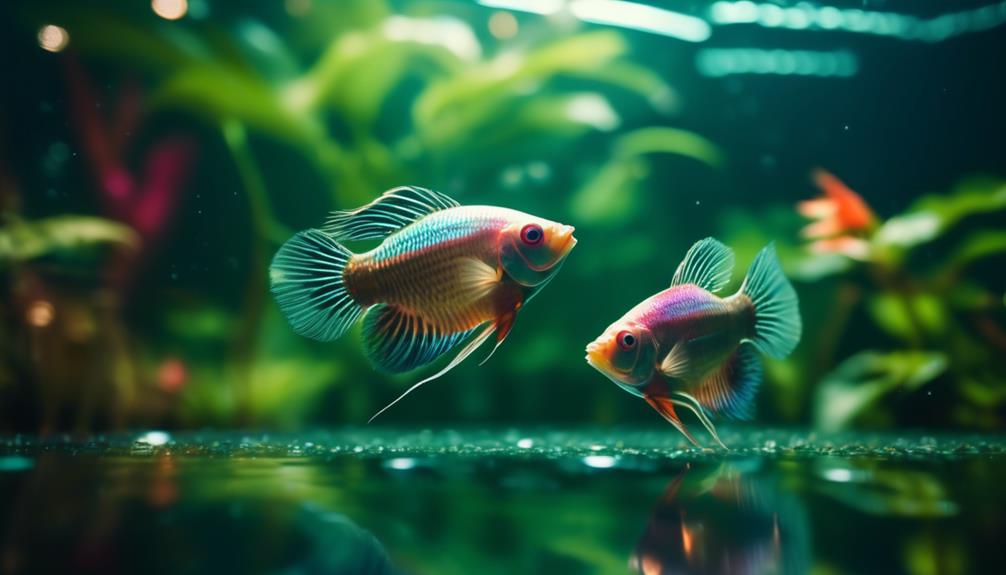
When attempting to breed gourami fish successfully, it’s crucial to follow these tips.
First, make sure to provide a separate breeding aquarium that’s dimly lit and well planted. This environment will mimic their natural habitat and encourage spawning.
Second, it’s important to have a male gourami in the aquarium as they’re the ones responsible for building bubble nests and caring for the eggs and fry.
Third, remove the female gourami from the breeding aquarium once spawning has occurred to prevent aggression towards the eggs.
Fourth, maintain optimal water conditions by ensuring the temperature is between 78 to 82 degrees Fahrenheit and the pH level is neutral.
Conclusion: Enjoy Your Colorful Gourami Fry
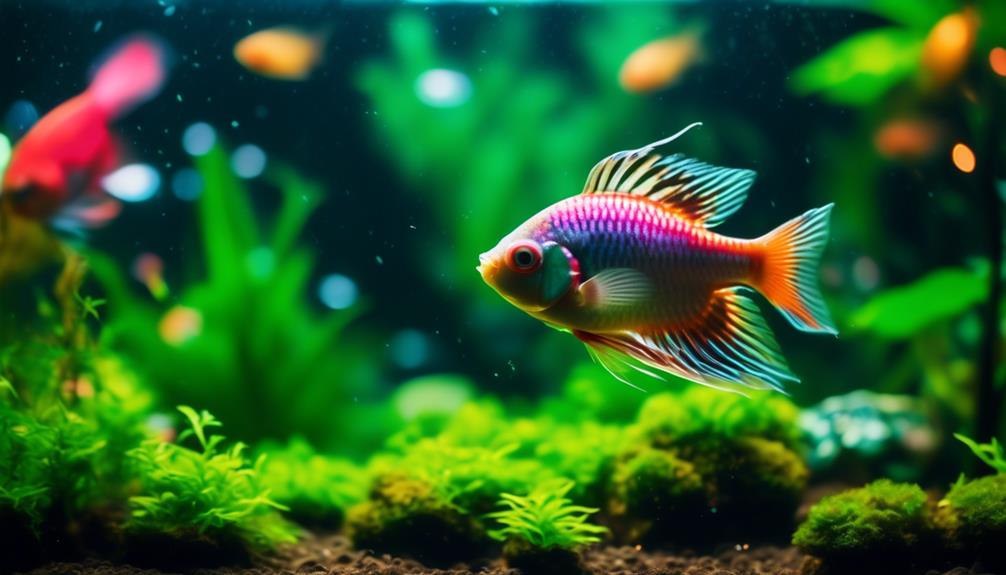
Now that you have successfully bred your gouramis, it’s time to enjoy the sight of your colorful gourami fry. Watching these tiny, vibrant fish grow and thrive can be a rewarding experience. Here are a few things to keep in mind as you continue to care for your gourami fry:
- Provide a suitable environment: Ensure that the fry have a well-planted aquarium with plenty of hiding places. This will help them feel secure and encourage their growth.
- Feed them appropriately: Gourami fry have small mouths and require tiny food particles. Offer them specialized fry food or crushed flakes to ensure they receive proper nutrition.
- Monitor water quality: Regularly test the water parameters and maintain a clean environment for the fry. This will promote their health and reduce the risk of diseases.
Frequently Asked Questions
What Are the Different Colors of Gourami Fish Available for Breeding?
There are various colors of gourami fish available for breeding, including blue, green, yellow, gold, pink, white, and red. They also come in multicolored varieties, providing a vibrant and diverse selection for breeders.
How Long Does It Take for Gouramis to Build a Bubble Nest?
It takes gouramis a few hours to build a bubble nest. They create these nests by using their saliva to cover bubbles. It’s fascinating to watch them prepare for breeding!
Can Gouramis Breed in a Community Tank With Other Fish?
Yes, gouramis can breed in a community tank with other fish. However, it is recommended to have a separate breeding aquarium to ensure the safety and success of the breeding process.
How Often Should the Breeding Tank Water Be Monitored During the Breeding Process?
During the breeding process, you should monitor the water in the breeding tank regularly. This ensures that the water conditions remain optimal for the gourami fry to hatch and develop properly.
What Are Some Common Challenges That Breeders May Face During Gourami Breeding?
Some common challenges breeders may face during gourami breeding include maintaining water quality, providing the right conditions for bubble nest building, ensuring successful spawning, and caring for the eggs and fry.
What Are the Breeding Secrets for Killifish Compared to Gourami Fish?
When it comes to colorful killifish care tips, it’s important to note that Killifish are known for their short lifespan, typically lasting 1-2 years. Breeding secrets for Killifish involve providing them with the right environment, including a suitable breeding substrate and proper water conditions. In comparison, Gourami fish require a more patient and carefully planned breeding process.
Conclusion
So there you have it, the secrets of breeding colorful gourami fish have been revealed!
By selecting a breeding pair, setting up the right tank, and creating an ideal environment, you can successfully breed these captivating creatures.
Understanding bubble nest building and dealing with potential challenges will ensure a smooth breeding process.
And don’t forget to prevent egg-eating behavior for a successful outcome.
Follow these tips and enjoy the beauty of your colorful gourami fry!




